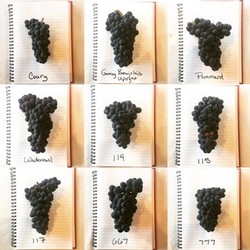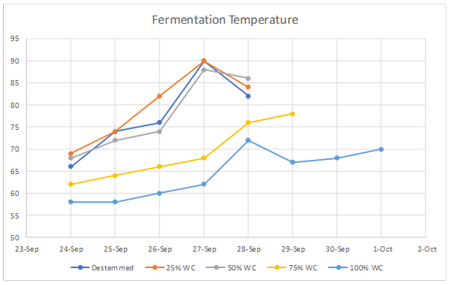🍇 Kramer Vineyards Blog: Discover Wine Tips, Stories, and More 🍷
Welcome to the Kramer Vineyards blog, your go-to resource for all things wine! From expert pairing tips and behind-the-scenes vineyard stories to seasonal inspiration, discover the artistry, history, and passion behind every bottle. Explore our latest articles and uncover new ways to enjoy exceptional wines.
Never Miss a Story!
Subscribe to the Kramer Vineyards newsletter for the latest wine tips, pairings, and stories.
2017 Harvest Report
Bud Break Through Veraison

 With our fullest crop in years, and a warm and dry forecast, we were on track for a big harvest. 2017 had some catching up to do for heat units, and by early September our GDDs were even with 2016. This, combined with low disease pressure, and an anticipated late September/early October harvest contributed to our decision to do minimal cluster thinning. In these conditions, carrying a heavier crop load forces the vine to work harder, slowing down ripeness, resulting in more balance.
With our fullest crop in years, and a warm and dry forecast, we were on track for a big harvest. 2017 had some catching up to do for heat units, and by early September our GDDs were even with 2016. This, combined with low disease pressure, and an anticipated late September/early October harvest contributed to our decision to do minimal cluster thinning. In these conditions, carrying a heavier crop load forces the vine to work harder, slowing down ripeness, resulting in more balance.
Six Weeks of Harvesting


On the Crush Pad and in the Cellar


For the white wines, fermentations were steady and healthy. Tank space is always a concern in years where yields are high, and in some cases, we elected to ferment in stainless or neutral barrels. In addition to barrel fermented Chardonnay, we also have Pinot Blanc, Pinot Gris, and Pinot Noir Blanc wintering over in barrels. These vessels will be stirred bimonthly through the spring, and either blended in with their tank counterpart to enhance mouthfeel and complexity, or be bottled on their own in the fall of 2018.
As we put another harvest behind us, the 2017s are wintering over in tanks and barrels. After the New Year, we’ll begin to taste the wines individually, and start to make blending decisions and form bottling plans. The first wines of the vintage will be available in a few months, some won’t be bottled until the spring of 2019. We are looking forward to what this record-setting harvest has in store.
Vintage vs Nonvintage in Sparkling Wines
Explore the distinction between vintage and nonvintage sparkling wines. Vintage wines reflect a specific grape harvest year, while nonvintage blends combine grapes from multiple years. In the US, wines labeled with a vintage year consist of 95% grapes from that year. Nonvintage wines, including those from Champagne, showcase the expertise of blending specialists who artfully combine base wines from different years to create a consistent house style.
At Kramer Vineyards, we have a unique approach to our sparkling wines. Our two nonvintage wines are estate-grown, showcasing the expression of our vineyard site. The composition of these wines varies, with each vintage offering its own character and style.
Notably, our Brut Reserve base wines undergo fermentation and aging in neutral French oak barrels, resulting in added richness, palate weight, and structure compared to stainless steel aging. Meanwhile, our 2015 vintage Brut stands as a wine of both place and time, benefiting from that year's warm and balanced fruit. With an increased proportion of Pinot Meunier in the blend, this vintage exhibits enhanced midpalate presence and fruity aromas. The fruit for this wine is sourced from dedicated blocks within our vineyard, and the blend is carefully determined based on the yields at harvest.
The nonvintage wines in the glass present a fine, delicate mousse with pronounced yeastiness and a focus on tree fruit flavors. On the other hand, the vintage wines captivate with their fresh, light nature, featuring a delicate and abundant bead and showcasing minerality and citrus notes. As these young wines evolve in the bottle, their tone and texture will transform, making it a thrilling journey to witness their progress.
Discover the nuances between vintage and nonvintage sparkling wines, the art of blending and the expression of our vineyard site, through the exceptional offerings from Kramer Vineyards.
Shop Kramer Sparkling Wines
2014 Whole Cluster Fermentation in Pinot Noir
What is Whole Cluster Fermentation?
What is Whole Cluster Fermentation? This refers to fermenting entire bunches of grapes, stems and all. Our grapes typically go through a de-stemmer, a machine that knocks the berries off the stems. In the process, many of the berries split and release juice immediately. When we bypass that step, the fruit stays intact longer, removing the sugar available to the yeast more slowly. This results in fermentations that take longer to complete at much lower temperatures. The shift in fermentation kinetics, along with the presence of the stem, impacts the aroma, flavor, and structure of the wine. Are these features beneficial to the overall quality? How much of the whole cluster is the ideal amount, if any? Will our ideas about this change as the wine ages? With the vintage? These are all questions we hope to answer through our whole cluster series.
The Experiment
In 2014, we harvested five tons of Pinot Noir from the same part of the vineyard and separated the fruit into five fermenters. We added a whole cluster layer in four of these vats, 25%, 50%, 75%, and 100%. The fifth bin was all destemmed. We proceeded with our typical fermentation management protocols, with pump-overs and punch-downs twice daily and pressed at dryness. The wines were aged in older French oak barrels and bottled in the winter of 2016.

Owner Keith Kramer, filling vats with destemmed Pinot Noir

The Results
We observed differences in the fermentation kinetics almost immediately. The vats with higher percentages of the whole cluster fermented at lower temperatures:
This also correlates with the fermentation rate, as indicated by the speed of sugar depletion.
Utilizing whole cluster fermentation as a technique seems to result in slower fermentation with lower temperatures. Cool, right?

Technical Details
We found that the chemistry of the finished wines was varied, although this could be due to differences in ripeness levels in the field and clonal differences throughout the block. It is important to note that each vintage is unique, so to learn anything meaningful from this exercise, we will need to repeat the experiment over multiple vintages in varying conditions.
The Wines
Our 2014 whole cluster Pinot Noir set includes one bottle of each experimental wine and the 2014 Pinot Noir Yamhill-Carlton, for six bottles. This collection is a lovely gift and fun to share at a dinner party or with friends.
Update: The 2014s are sold out, but the experiment was replicated in 2015. You can find those wines here >>

Harvest 2017 Begins
 Although most of vintage 2017 has been warm and dry, the season had a bit of a delayed start. We had budbreak in late April, about two weeks behind average for our site. April showers continued well into May, so when the sun finally came out, the canopy filled in quickly. The vineyard reached 50% bloom on June 24. This is a significant milestone, as harvest for the Pinot Noir will occur about 110 days from that stage, around October 12. Once summer weather arrived in mid-June, we racked up the growing degree days, catching up with 2016 by August. The next growth stage, 50% Veraison, occurred on August 28, supporting our estimate of an October 12 harvest date.
Although most of vintage 2017 has been warm and dry, the season had a bit of a delayed start. We had budbreak in late April, about two weeks behind average for our site. April showers continued well into May, so when the sun finally came out, the canopy filled in quickly. The vineyard reached 50% bloom on June 24. This is a significant milestone, as harvest for the Pinot Noir will occur about 110 days from that stage, around October 12. Once summer weather arrived in mid-June, we racked up the growing degree days, catching up with 2016 by August. The next growth stage, 50% Veraison, occurred on August 28, supporting our estimate of an October 12 harvest date.
Grapes for sparkling wines are harvested a bit earlier to capture the naturally higher acidity. For these wines, we are looking for sugar levels in the 18-20 Brix range, compared to 21-24 Brix for the table wines. The photo above is from our first round of sampling and testing the sparkling varieties for ripeness on September 6.
 Our sparkling harvest began on September 15, with the Pinot Meunier (the image to the right is of the Pinot Meunier harvest) and the Muscat. The Chardonnay and Pinot Noir were picked on September 17, followed by Pinot Blanc on September 24. We also received fruit from vineyards in Banks, Dundee, Gaston and Yamhill.
Our sparkling harvest began on September 15, with the Pinot Meunier (the image to the right is of the Pinot Meunier harvest) and the Muscat. The Chardonnay and Pinot Noir were picked on September 17, followed by Pinot Blanc on September 24. We also received fruit from vineyards in Banks, Dundee, Gaston and Yamhill.
Traditional sparkling enthusiasts can look forward to Brut, Blanc de Noirs, Blanc de Blancs, and Brut Rosé from this vintage, and some zero dosage bottlings of these cuvees. For the Celebrate collection, those grapes are still hanging on the vine…
